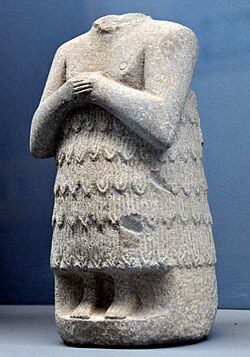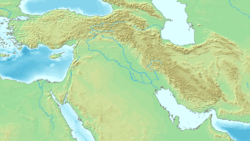Nin-kisalsi facts for kids
Quick facts for kids Nin-kisalsi𒎏APOLIS |
|
|---|---|

Headless votive statue, from Adab, Iraq, early dynastic period. Museum of the Ancient Orient, Istanbul
|
|
| Reign | 26th century BCE |
| Dynasty | Dynasty of Adab |
| Religion | Sumerian religion |
Nin-kisalsi (Sumerian: 𒎏APOLIS) was an ancient ruler from Sumer. He governed the city of Adab in Mesopotamia. He lived around 2500 BCE, which was a very long time ago!
Contents
Who Was Nin-kisalsi?
Nin-kisalsi was a leader in the ancient land of Sumer. Sumer was a powerful civilization in what is now Iraq. He ruled the city-state of Adab. This city was an important center in ancient Mesopotamia.
Ruler of Ancient Adab
Adab was one of many city-states in Sumer. Each city-state had its own ruler. Nin-kisalsi was the ensi of Adab. An ensi was like a governor or a local king. He was responsible for the city's well-being.
How Do We Know About Him?
Nin-kisalsi's name is not found on the famous Sumerian King List. This list names many early Sumerian kings. However, we know about Nin-kisalsi from a special object. His name was carved into it long ago.
The Mesilim Inscription
Historians found a piece of a stone bowl. This bowl has writing on it. This type of carving is called an inscription. The inscription mentions Nin-kisalsi. It says:
𒈨𒁲 𒈗𒆧𒆠/ 𒂍𒊬 𒁓 𒈬𒄄 / 𒎏APOLIS} 𒑐𒋼𒋛 𒌓𒉣
"Me-silim, king of Kish, to the Esar temple sent over (this) bowl (for the burgi ritual). Nin-KISALsi, (was) the governor of Adab."
—Inscription of Mesilim mentioning Nin-Kisalsi
This inscription is very important. It tells us about Nin-kisalsi's time. It also shows his connection to another powerful king.
Nin-kisalsi and King Mesilim
The inscription mentions King Mesilim of Kish. Kish was another strong city-state. It seems that Mesilim was a more powerful king. Nin-kisalsi was likely under his rule. This means Nin-kisalsi was a "vassal" of Mesilim. A vassal ruler was loyal to a more powerful "suzerain" king. They lived at the same time. Another ruler, Lugalshaengur of Lagash, was also a vassal of Mesilim. This shows how power was shared in ancient Sumer.


